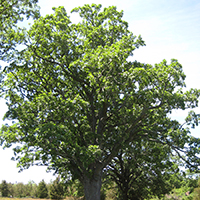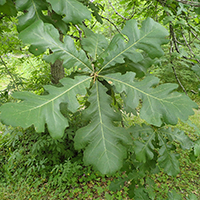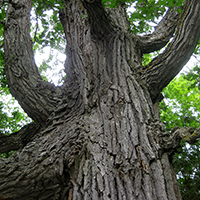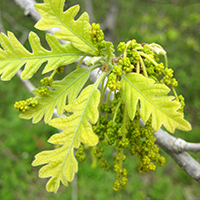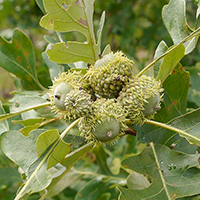What bur oak looks like
Size and shape
- Medium-large tree, reaching 15 to 30 metres tall.
- Trunk reaches 60 to 120 centimetres in diameter.
- Usually grows tall with a straight trunk.
- In shallow soil, may be smaller with a twisted trunk and gnarled branches.
Leaves
- Large leaves (15 to 25 centimetres long).
- Shiny green on top and pale and hairy underneath.
Bark
- Thick, dark grey bark with deep furrows.
Flowers
- Long, green catkins appear with leaves in spring.
Fruit
- Acorns are 1.5 to 3 centimetres long.
- Have a deep cup covering two thirds of the acorn.
- Cup has a bristle fringe around the upper edge.
Where bur oak is found
Bur oak is the most common oak in Ontario. It grows across Southern Ontario and along the borders with Minnesota and Manitoba in Northwestern Ontario.
What you need to know to grow bur oak
- Moisture: tolerates a wide variety of moisture conditions.
- Soil: grows in a variety of soils.
- Shade: grows best in full sun but tolerates moderate shade.
- Cautions:
- Space: bur oaks have deep roots, so avoid planting near underground pipes.
- Disease: oak wilt is caused by an invasive fungus that has been found in Southern Ontario. To minimize the risk of oak wilt, save pruning for before April and after July, when beetles thought to transport the fungus are less active.
- Note: bur oaks can survive transplanting and grow well in cities.
Benefits and uses of bur oak
Wildlife benefits
Bur oak acorns are a food source for many mammals, including:
- bears
- squirrels
- livestock
- rabbits
Bur oak trees also provide habitat for birds and browse for deer.
Commercial uses
Bur oak wood is used for:
- cabinetry
- furniture
- flooring
Bur oak trees are a good choice for urban planting because they can tolerate air pollution and various growing conditions.
Fun facts about bur oak
- Bur oaks have very thick bark that helps them survive forest fires.
- Their deep roots help them tolerate drought.
Updated: November 22, 2023
Published: July 18, 2014
